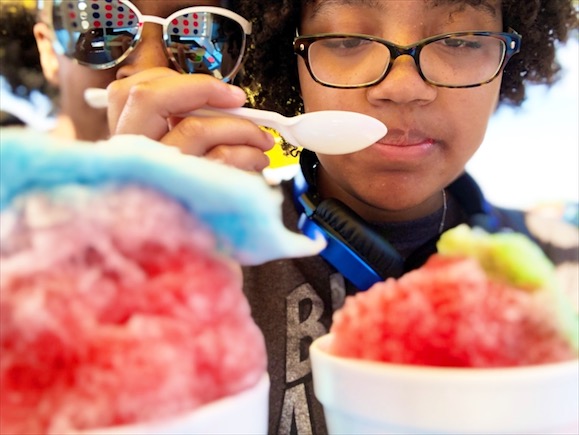
If you’ve been following along on my Insta Stories, you know my 13-year-old daughter was diagnosed with Ocular Myasthenia Gravis in April. She originally showed signs of the autoimmune disease at the beginning of 2016 when her right eyelid became droopy, also known as Ptosis. It caused a myriad of problems for her including diminished and double vision. At the time, we went from seeing the Optometrist to the Opthomologist to a Pediatric Neurologist. She had many vision test and blood test, but all we were given was a temporary patching job on her glasses. We never got any definitive answers on what was going on with her.
Surprisingly, the temporary patch job did work and she continued on with her life per usual. Everything seemed fine until January of this year when I noticed her eyes didn’t seem to be focusing in the same direction. We headed back to the Opthomologist where more test were performed. This time, in conjunction with a blood test he performed an ice test to determine if the presence of ice lifted her lid. It did and once removed, the lid started to droop again after a few seconds. The results of both tests are what finally led to an Ocular Myasthenia Gravis diagnosis.
WHAT IS OCULAR MYASTHENIA GRAVIS
The short of it is Myasthenia Gravis is an autoimmune disease where antibodies attack and destroy nerve-muscle connections. Ocular Myasthenia Gravis is specific to the eye muscles. From what we were told, it’s extremely rare and they don’t know what brings it on in the first place. The rarity is what makes it difficult to diagnose and even more difficult to get under control.
There is no cure, but it can go into remission, which is what happened in V’s case when it initially started in 2016.
BE YOUR CHILD’S ADVOCATE
No one loves your child like you do and your emergencies aren’t going to be theirs. Doctors have patients on their books already and they’re rolling on a first come, first serve basis at the desk. When you need an appointment, of course, you want to call the office first, but in our case, we were told we’d have to wait 6 months before V could in it. This is totally unacceptable for a nerve-racked parent whose child suddenly can’t open their eyelids high enough to see.
Rather than wait, we contacted the Optometrist who was able to get us a same day appointment with the Opthomologist and their office was able to do the same for the Pediatric Neurologist. If you aren’t happy with the results you’re getting by going through the front door, use the back. Rarely is your child able to advocate for themselves and this is the one area you are able to have control in.
CHRONICLE THEIR DAYS
I will admit this is something I didn’t do in the beginning and I really wish I had. We were going to so many appointments and every time we’d get asked the same questions of when it first started when it changed when various things were happening and I couldn’t keep all the dates together after a while. I was relying on looking at a calendar without actually marking the dates. Not only did I start tracking the dates, after V started medicine that seemed to make things worse, I started taking pictures every morning for a visual aid. Not only did this make appointments easier, the visual made it easier when explaining to the teachers what was going on.
COMMUNICATE WITH YOUR TEEN’S SCHOOL
Before V’s Myasthenia Gravis returned in January my only school worry was making sure she didn’t have too many absences due to period pains or family vacations. With its return, we were suddenly dealing with absences due to doctor’s appointments, testing, horrible stomach pains from the medicine, etc …
While it was clearly noticed something was going on with her eyes, I reached out to all of her teachers to let them know the specifics. I attached an image so they could clearly how drastically things could change from one day to the next. I let them know side effects of her medication and how the disease in general just depletes her of energy, so if she appears wiped out she needs to take a break to rest.
Her teachers were amazing and made adjustments to accommodate her needs. Things that seem so simple like allowing a bottle of water in class or taking multiple trips to the bathroom mean a lot and likely wouldn’t be possible without consistent communication.
FIND WHAT WORKS BEST FOR YOUR TEEN
Myasthenia Gravis is referred to as the “snowflake disease” because it’s so different from person to person. V was prescribed Mestonin syrup, which came with a hefty $600 price tag and little results. We were told it should take effect almost immediately, so we were all disappointed to see little to no change after weeks using it. We tried switching up the dosage based on what the Pediatric Neurologist was directing, but the only thing that happened was intense stomach cramps.
When her refill was due, rather than sticking with the syrup, we switched to the generic pill version, crushing the pills to make them easier to swallow, but after 2 days it was clear they made V’s symptoms worse. She reverted back to double vision, her eyes were no longer level, and her left eyelid wouldn’t open. On top of those issues, the pill caused crippling stomach cramps and diarrhea that kept her home and sent her to the bathroom every 20 minutes.
As you can imagine, V became discouraged with taking the medication, so we discontinued it, knowing it doesn’t work for everyone and it clearly wasn’t working for her. We decided to revert back to her 2016 treatment of patching, but this time, rather than taping her glasses lense, I purchased a patch that would completely cover her eye. She only wears the patch in the house and places it over the stronger eye for a couple of hours each day.
So far patching is working for her. Her double vision has subsided and her lids are typically fine. You can tell when she’s tired, has exerted too much energy, or is overheating because her lids do appear to drop, but once she gets some rest, some water, or just sits down for a bit, they raise back into place.
It has been beyond frustrating throughout this journey, but I know it’s still worse for V. Figuring out how to cope with her Ocular Myasthenia Gravis diagnosis has been tough and a series of trial and error. I know there’s nothing I can do to make it go away, so I do the things that make her days easier. Advocating for her, tracking what’s going on, and making sure her teachers are aware are all things that add up to easily, more effectively, managing her Ocular Myasthenia Gravis and, hopefully, getting her back into remission.

